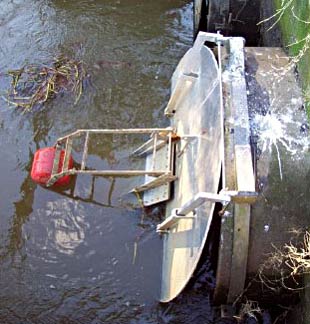
Managing salt water when opening floodgates
Controlled opening of floodgates and flushing of river water into drains can improve drain water quality, help manage aquatic weeds and also provide fish passage. Because of these and other benefits, opening of floodgates is being undertaken in many drains on coastal floodplains in NSW.
Most drains on coastal floodplains connect to parts of the river that are influenced by salt water, particularly during dry periods. The land next to drains can be very low, sometimes below local high tide levels. Many agricultural plants have low tolerance to excess salts in the root zone.
For farmers, managing salinity is one of the most important issues to understand when opening floodgates. While salt represents a real risk for agriculture, this risk can be managed.
What is the issue?
There are two main issues associated with salt when opening floodgates.
These are
- saline water overtopping drains and going over the surface of the land
- lateral seepage of saline drain water into adjacent soil.
It is important to understand and know how to manage these issues.
Prevent overtopping
If saline water overtops dry land the salt may be slow to leach out. Note that salt concentrations in coastal rivers are very seasonal and are highest during dry periods. If the river water is fresh then overtopping is obviously less of an issue.
Controlling drain water levels is the key to prevent overtopping of land. You need to ensure that any saline water entering the drain through floodgate opening remains confined to the drain. To do this you have to know the elevations of low points next to the drain and how these elevations relate to local tidal levels. The entire drain network should be considered. If the lowest land is above your local tide range, overtopping will not occur.
However, if land elevations next to the drain are within the tidal range, it is critical to control drain water levels. A range of floodgate opening devices exist which close automatically when the water level reaches a set height (Figure 1). Such automatic devices are preferred if you have land prone to overtopping.

If you have a manual opening device (such as a winch gate) you will need to be more careful. Take careful note of the local tide cycles and river salinity levels and make sure the floodgate is closed before overtopping occurs.
Preventing salt seepage
The risk of salt seeping from drain water into the adjacent soil/groundwater is normally low at most sites. However it can occur, particularly if the soil next to the drain is highly permeable.
There are two important factors that control the risk of seepage.
- Soil permeability next to the drain: This determines how quickly water moves through the soil. While it is normally low in most coastal floodplain soils, it can be very high in some swamps with acid sulfate soils. Seeking professional assistance to assess soil permeability is worthwhile.
- Groundwater levels or gradients: If the local groundwater level is higher than the drain water level, this ‘gradient’ will help prevent salt moving away from the drain. Groundwater gradients are influenced by many factors including elevation, rainfall and evaporation. See the website under 'Further information' for details:
Setting a salinity threshold for floodgate opening is a simple way of preventing salt seepage. This can be based on existing groundwater salinity levels. Once the adjacent river water salinity reaches the threshold, the floodgates are closed.
Other things to consider
Mole drains, commonly found in sugar cane areas, can conduct water rapidly away from the drain. If you have mole drains you need to ensure that saline water does not enter them.
Increased salinity in drains can make the water undrinkable for stock. There are useful tools to help you manage salt.
- Inexpensive hand-held salinity meters allow you to keep track of salt levels in the river.
- Tide boards in the drain help you to monitor drain water levels.
- Tide charts help you decide the timing for opening manual floodgates.
Assessing the drainage system before opening the floodgates is vital. Various state and local government organisations have expertise in this field and can be contacted for assistance.
Further information
For further information, advice and assistance on floodgate and drain management contact NSW DPI.
Citation: Johnston S, Bruce A, Kroon F (2004) Floodgate and drain management on coastal floodplains leaflet 4: Managing salt water when opening floodgates. (NSW Agriculture: Wollongbar)

